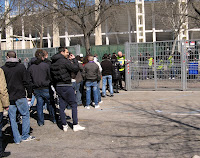 |
| Strozzi Palace |
On our first visit we walked through the gallery several times, quickly the first time, more slowly the next two times. The Stozzi is nine or ten rooms, the entire second floor of the building. It is possible to walk through the whole exhibit in five or ten minutes and we think that it is a good idea to start such a show with a sense for the whole. We were dazzled; afterwards there were lots of images floating around in our heads. One of us hard a hard time sleeping that night.
Today we went through the show once with the audio tour, a little iPod looking device with a pair of earphones. Many of the paintings were marked with a number. Step in front of a painting, note the number posted below the painting, enter the number into the device, and hear a commentary on that particular painting. The narration helped to add context.
 |
| Early Picasso (source) |
 |
| Late Picasso (source) |
Dali was interesting but sometimes bizarre. As a young man he was thrown out of art school because he said that none of his professors were good enough to judge his work. He may have been correct but the stresses in his family that resulted were unfortunate.
We found Miro to be very interesting. We knew very little about him. Like Dali he was younger than Picasso and influenced by his work. But Miro seemed to develop a unique visual language and left us wishing there were more of his work to view.
 |
| Miro, Small Universe Two fish, one mermaid (source) |
After the show we crossed over the Arno for a meal at one of Florence’s fine restaurants, Osteria del Bricco. It was quiet on the other side of the Arno, the wave of tourists don’t get very far across the river. It’s a shame because Bricco is a jewel.
We started our lunch with a sformato appetizer which we shared. A sformato is a shredded or chopped mass of a cooked vegetable, sauteéd in butter, flavored with grated parmignano and perhaps a little nutmeg, held together with egg, bechamel, and/or mashed potato, and baked in an hot oven until a crust forms. The sformato appetizer at Bricco is five small pieces of sformato, one each of the spinach, cauliflower, potato, carrot, and zucchini versions. You look forward to the first bite; you regret the last.
We’ve had this dish before, of course, and the rest of the meal was a wonderful way to celebrate a memorable show of artists and art and a beautiful, sunny day. Besides Picasso, Miro, and Dali, the sformati are what we’ll remember ... until the next sformato appetizer which we’ll have in Monticchiello, a tiny medieval village near Montepulciano.
Tomorrow we pack up our Ghibellina apartment and Saturday morning we’ll drive to Umbria.



































